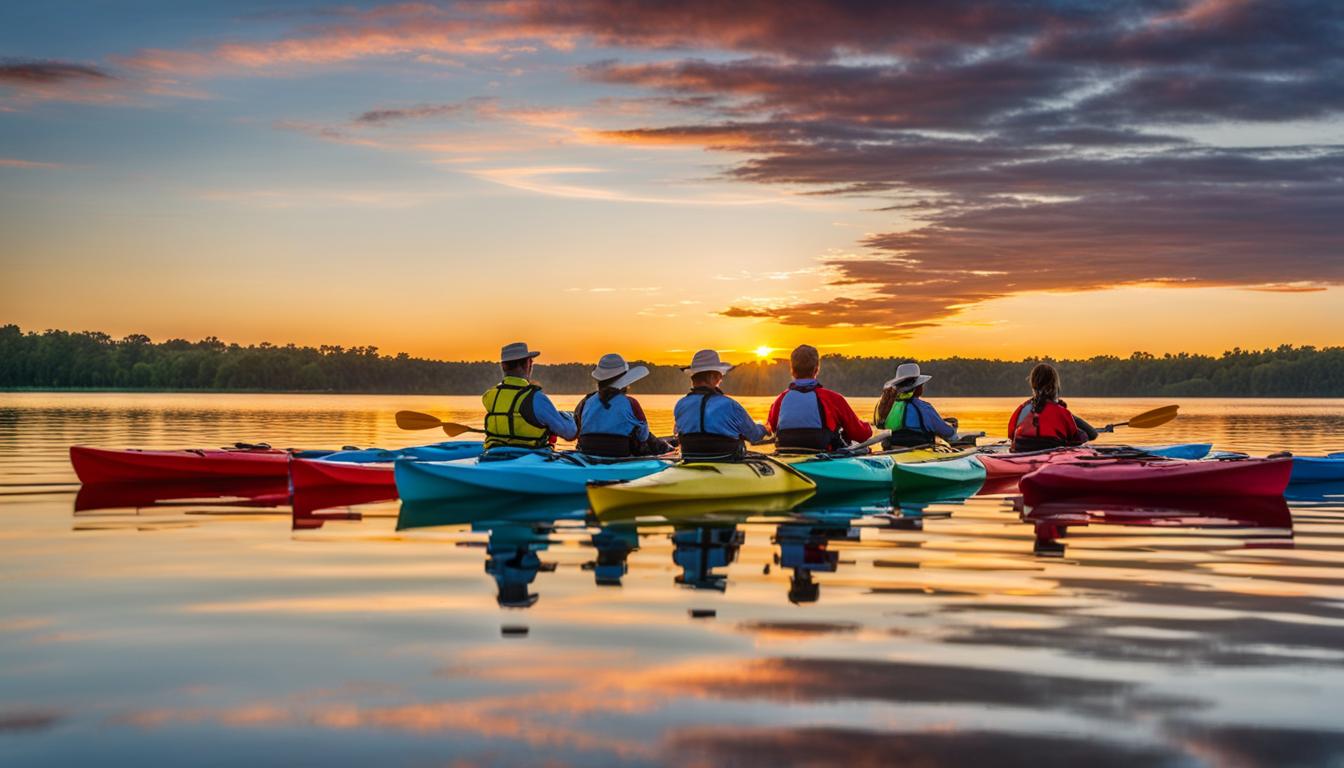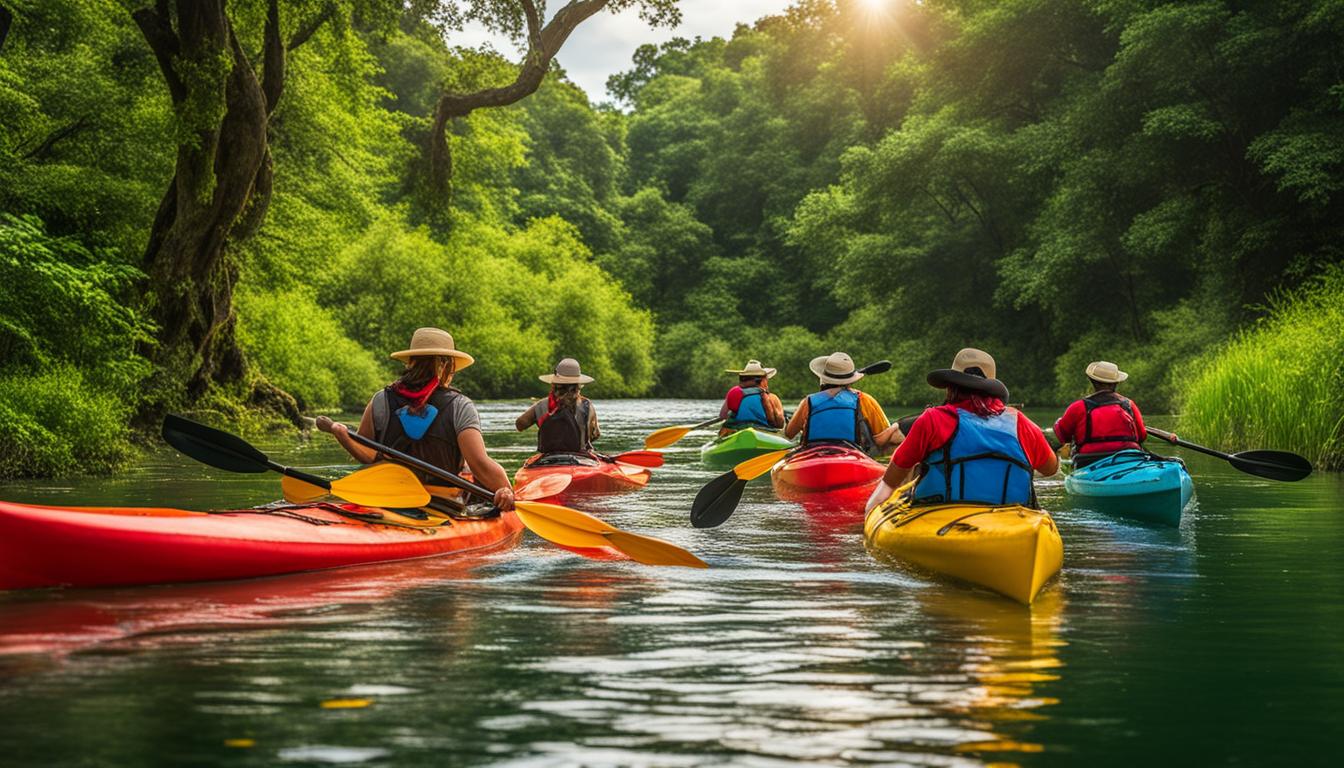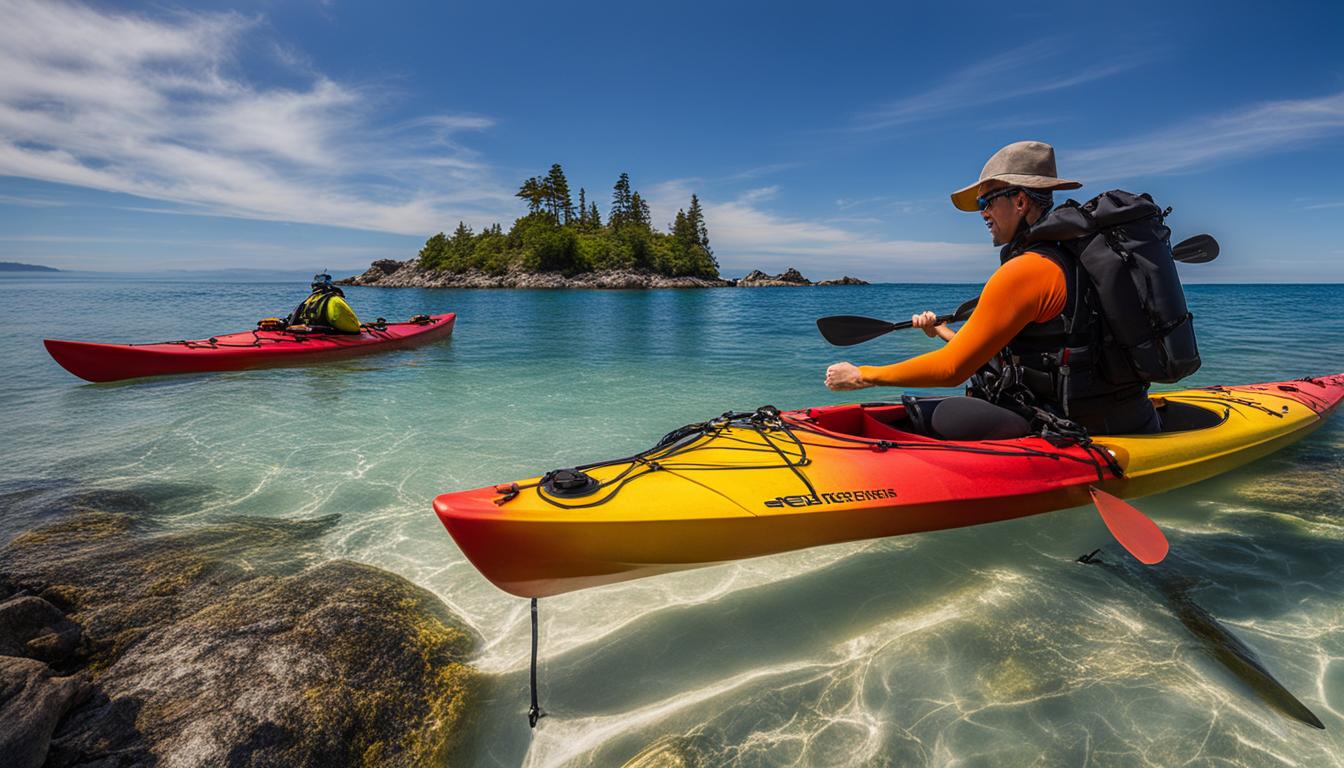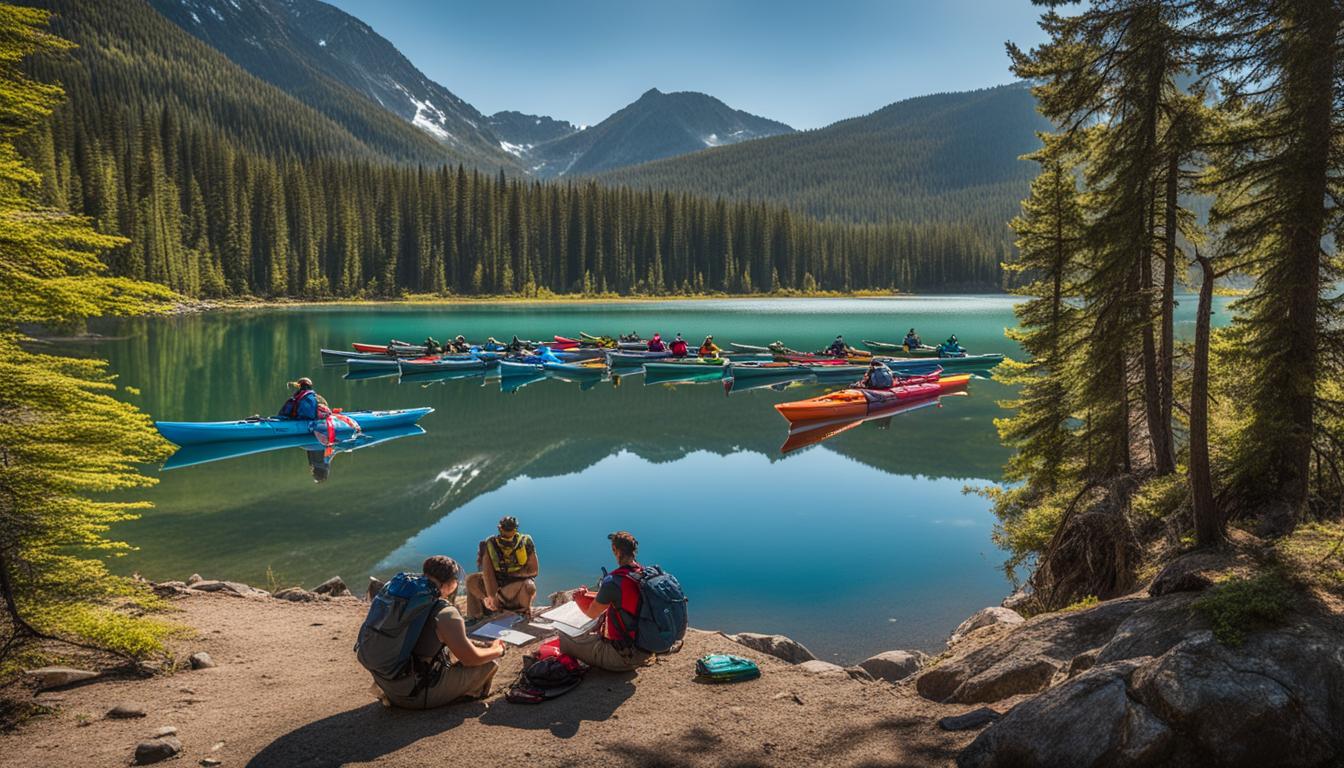Are you dreaming of embarking on a thrilling multi-day kayak expedition? Planning such an adventure requires careful consideration and preparation. But fear not! In this step-by-step guide, we will walk you through the essential aspects of planning your unforgettable kayak journey.
Key Takeaways:
- Research extensively to gather information about the area you plan to kayak in.
- Choose the right kayak for your expedition based on its length and shape.
- Create a detailed itinerary, accounting for distance, camping spots, and potential obstacles.
- Stay informed about weather conditions and adjust your plans accordingly.
- Thorough planning, preparation, and attention to detail are crucial for a safe and enjoyable journey.
Choosing the Right Kayak for Your Expedition
When embarking on a multi-day kayak expedition, selecting the right kayak is essential for a successful and enjoyable journey. Consider the following factors when choosing your kayak:
Length and Shape:
Longer kayaks with pointed bows and sterns are highly recommended for expeditions. These sleeker designs provide better speed and tracking, allowing you to cover greater distances more efficiently. Additionally, longer kayaks typically offer ample storage space, allowing you to pack all the essentials for your trip.
Stability:
While speed and storage are important, it’s equally crucial to find a kayak that offers stability. Look for models with a wider beam, which provides better stability, particularly in rough waters or challenging conditions. A stable kayak will give you the confidence you need to navigate various water conditions without compromising safety.
Material:
Consider the material of the kayak, as it can impact the weight, durability, and overall performance. Popular materials include polyethylene, fiberglass, and carbon fiber. Each has its own advantages and disadvantages, so research and test different materials to find the one that suits your needs and preferences.
Paddle:
Don’t forget to choose the right paddle for your expedition. Look for a lightweight and sturdy paddle that provides efficient propulsion and minimizes fatigue. Adjustable paddles are especially useful as they allow you to customize the length based on your height and paddling style.
Remember, investing in a high-quality kayak and paddle can greatly enhance your overall experience during your multi-day kayak expedition. Consider renting or borrowing different kayak types and sizes before making a final decision. Take the time to test them out on the water to determine which one feels the most comfortable and suits your specific needs.

| Kayak Model | Length | Shape | Stability |
|---|---|---|---|
| Model 1 | 12 ft | Recreational | High |
| Model 2 | 16 ft | Touring | Medium |
| Model 3 | 14 ft | Sea Kayak | High |
Table Note: The table provides a comparison of different kayak models based on their length, shape, and stability. This information can help you make an informed decision when choosing the right kayak for your expedition.
Planning Your Itinerary and Logistics
When embarking on a multi-day kayak trip, proper planning of your itinerary and logistics is crucial to ensure a smooth and enjoyable journey. Here are some essential tips to help you plan your kayak expedition effectively:
Research and Map Your Route
Begin by thoroughly researching the area you plan to kayak in. Look for reliable guidebooks, online resources, and consult with experienced kayakers who have previously explored the same route. Use tools like Google Earth to get a visual understanding of the landscape and identify potential landmarks.
Once you have gathered enough information, map out your route. Consider the starting and ending points, recommended paddling distances per day, and potential camping spots along the way. Take into account factors like water levels, weather conditions, and any access limitations that may require permits or permissions.
Plan for Safety and Contingencies
While planning your itinerary, prioritize safety and be prepared for unforeseen circumstances. Check weather forecasts regularly before and during your expedition to anticipate any changes in weather conditions. It’s crucial to be aware of potential hazards such as strong currents, underwater obstacles, or areas prone to sudden weather changes.
Additionally, plan for contingencies by including alternative routes or emergency extraction points in your itinerary. Share your itinerary with a trusted contact who can check in on your progress and alert authorities if needed.
Pack Wisely and Consider Weight Distribution
As you plan your itinerary, carefully consider the gear and supplies you’ll need for the journey. Pack essentials such as food, water, safety equipment, navigation tools, camping gear, and clothing suitable for various weather conditions. However, it’s important to balance your provisions to avoid overpacking and ensure your kayak maintains stability.
Organize your gear in dry bags and distribute the weight evenly across your kayak. This will help maintain stability and maneuverability, especially in challenging conditions. Consider using deck bags or storage compartments designed specifically for kayaking to optimize space and accessibility.
| Key Points: | Benefits: |
|---|---|
| Thoroughly research and map your route | Ensure you navigate safely and efficiently |
| Plan for safety and contingencies | Be prepared for unexpected situations |
| Pack wisely and consider weight distribution | Maintain stability and maneuverability |
By following these guidelines, you can plan your kayak expedition effectively, making the most of your journey while prioritizing safety and enjoyment.
Ensuring Safety and Preparedness
When preparing for a long kayak trip or planning a kayak adventure, safety should be your top priority. By taking the necessary precautions and being prepared for any situation, you can ensure a smooth and enjoyable journey. Here are some essential tips to help you stay safe on the water:
1. Check the weather forecast
Before embarking on your kayak expedition, make it a habit to check the weather forecast regularly. Stay informed about any upcoming changes in weather conditions and be prepared for sudden changes. Adjust your itinerary accordingly and avoid paddling in unsafe conditions such as strong winds, storms, or heavy rainfall.
2. Pack essential safety gear
Always pack essential safety gear to ensure your preparedness on the water. This includes a personal flotation device (PFD) that fits properly, a whistle or signaling device to attract attention if needed, a first aid kit, a knife or multi-tool, and a waterproof map or navigation equipment. It’s also a good idea to bring a communication device such as a waterproof smartphone or a VHF radio to stay connected in case of emergencies.
3. Practice your skills
Before heading out on a long kayak trip, make sure you have the necessary skills and experience to handle different paddling conditions. Practice your paddling techniques, self-rescue maneuvers, and navigation skills. Familiarize yourself with the area you plan to kayak in and learn about any potential hazards or challenges that you may encounter along the way.
Remember, being well-prepared and knowledgeable about safety precautions can make a significant difference in ensuring a safe and enjoyable kayak adventure. Prioritize safety, stay informed, and be prepared for unexpected situations to make the most of your journey.

Conclusion
Planning a multi-day kayak expedition requires thorough research, careful preparation, and attention to detail. By following the steps outlined in this guide, you can ensure a safe and enjoyable experience on your journey.
When it comes to kayak expedition planning, remember to gather as much information as possible about your chosen area. Use guidebooks, online resources, and personal connections to understand the landscape and any permits or permissions required. Tools like Google Earth can provide a visual understanding of the terrain.
Choosing the right kayak is essential for a successful expedition. Opt for longer kayaks with pointed bows and sterns, as they offer better speed, tracking, and storage space for your gear.
Plan your itinerary and logistics carefully, taking into account factors like recommended paddling distances, camping spots, water levels, weather conditions, and access limitations. Regularly check weather forecasts and be prepared to adjust your plans accordingly.
With these kayak expedition planning tips in mind, you’ll be well-prepared for your journey. Pack your gear thoughtfully, stay informed about safety measures, and embark on your multi-day kayak expedition with confidence. Enjoy the adventure!
FAQ
How can I research the area for my kayak expedition?
Research your expedition by gathering information from guidebooks, online resources, and personal connections. Use tools like Google Earth to get a visual understanding of the landscape. Take note of any permits or permissions required for access.
What type of kayak should I choose for a multi-day expedition?
Longer kayaks with pointed bows and sterns are generally better for expeditions as they provide better speed and tracking. They also offer more storage space for gear.
How should I plan my itinerary for a kayak expedition?
Create a detailed itinerary that includes the starting and ending points, recommended paddling distances per day, and potential camping spots along the way. Consider factors like water levels, weather conditions, and access limitations.
How can I stay informed about weather conditions during my expedition?
Check weather forecasts regularly before and during your expedition. Be prepared for changes in weather and adjust your plans accordingly. Avoid paddling in unsafe conditions.
What is important to consider when planning a multi-day kayak expedition?
Planning a multi-day kayak expedition requires thorough research, careful preparation, and attention to detail. By following the steps outlined in this guide, you can ensure a safe and enjoyable experience on your journey.





